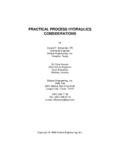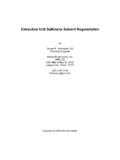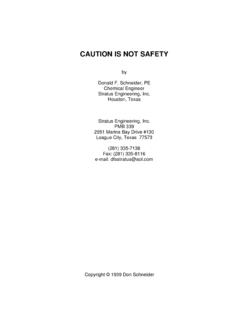Transcription of Select the Right Hydrocarbon Molecular Weight …
1 I Select the Right Hydrocarbon Molecular Weight Correlation By Donald F. Schneider, Chemical Engineer Stratus Engineering, Inc. PMB 339 2951 Marina Bay Drive #130 League City, Texas 77573 (281) 335-7138 Fax: (281) 335-8116 E-mail: Copyright 1998 Don Schneider Stratus EngineeringStratus EngineeringStratus EngineeringStratus Engineering 1 Introduction Computer models of systems processing wide boiling range Hydrocarbon streams typically employ pseudocomponent representations of distillation fractions. In this method, commonly known bulk properties such as boiling point and gravity distributions are used in correlations to derive physical properties for petroleum fractions (pseudocomponents).
2 These derived characteristics represent the properties of a mixture that is not, or cannot be characterized by its individual chemical species. Even mixtures that can be precisely defined by specific compounds are often represented as a collection of pseudocomponents. Where such an approximation does not materially affect the results obtained, this simplification can greatly reduce the calculational magnitude of a problem. Because experimental Molecular Weight determinations of Hydrocarbon fractions are difficult, Molecular Weight is one physical characteristic that is often calculated for pseudocomponents using a correlation.
3 Molecular Weight is an important factor in analyzing the performance of Hydrocarbon processing systems. It directly impacts chemical equilibrium, reaction kinetics and vapor density calculations. Accurately describing the Molecular Weight of Hydrocarbon fractions is important to proper analysis and design of chemical processing systems. A variety of mathematical relationships have been developed to predict pseudocomponent Molecular weights. These correlations are usually based on boiling point and gravity data, but have also been based on viscosity and UOP K.
4 The numerous equations produce a wide range of Molecular Weight estimates for heavy Hydrocarbon fractions. The continuing growth in the importance of heavy oil processing increases the need for understanding Molecular Weight prediction methods and their impact on unit operation, process simulation, and design. Stratus EngineeringStratus EngineeringStratus EngineeringStratus Engineering 2 Molecular Weight The importance of Molecular Weight to a chemical system is observed whenever the kind of molecule present, not just the amount that is present, is critical. Phase equilibrium, reaction kinetics, and vapor densities are three areas where component Molecular Weight plays an important role.
5 Thermodynamic phase equilibrium is one of the most important areas where this comes into play. Distillation, absorption, and extraction are some of the processes whose performance is based on phase equilibrium. Distillation depends on vapor-liquid equilibrium. For a vapor to be in equilibrium with a liquid, the fugacity of each phase must be equal. If the vapor is assumed to be an ideal gas, and the liquid is assumed to be an ideal solution, Raoult's Law (equation 1) results describing vapor-liquid equilibrium. From this simplified expression, the importance of Molecular Weight can be seen. If the Molecular Weight of a component is improperly defined, the mole fractions of all components are altered leading to inaccurate equilibrium calculations.
6 Yi P = xi Psati (1) P = Total system pressure yi = Mole fraction of component i in the vapor xi = Mole fraction of component i in the liquid Psati = Vapor pressure of component i at the system temperature When distilling 100,000 lbs/hr of material, it makes a great deal of difference if you have 1,390 moles/hr of 72 average Molecular Weight material, or 250 moles/hr of 400 average Molecular Weight material. The impact is felt because equilibrium is established at defined conditions by the type and number of molecules present rather than the mass of material available. In chemical reactions, the number of molecules present of each type of compound affects every aspect of the reaction.
7 In heavy Hydrocarbon processing, this is important to FCC Units, Hydrotreaters, and Cokers. Reactions occur by the type and number of molecules present, not by the Weight of reactive mass available. Equation 2 describes a typical hydrotreating reaction. If the Molecular Weight of a reactant is improperly defined, the required amount of other reactants, in this case hydrogen, is altered. In hydrotreating heavy stocks, this could lead to incomplete conversion or coking. C12H24 + H2 C12H26 (2) Hydrocarbon vapor densities are directly dependent on Molecular weights.
8 This is less true of liquids where, by definition, there are strong intermolecular interactions. The simplistic ideal gas expression of Equation 3 has been rearranged in Equation 4 to allow easier identification of the influence of Molecular Weight on vapor density. If the Molecular Weight of a species is improperly defined, calculated vapor densities are altered leading to inaccurate vapor dependent calculations such as flow hydraulics and fractionation equipment ( trays) loadings. Stratus EngineeringStratus EngineeringStratus EngineeringStratus Engineering 3 P V = n R T (3) = m / V = P (MW) / R T (4) P = Pressure V = Volume n = Number of moles R = Gas constant T = Temperature m = Mass = Density MW = Molecular Weight Stratus EngineeringStratus EngineeringStratus EngineeringStratus Engineering 4 Correlations Because of the difficulty and cost associated with laboratory Molecular Weight determinations, heavy Hydrocarbon Molecular Weight estimations are typically made based on known gravity (density) and boiling point data.
9 This information is more easily supplied by laboratory analyses. Curves defining the boiling point versus gravity relationship are produced using standard test methods. These data are then employed in Molecular Weight prediction. Viscosity versus boiling point data, similarly available from laboratory analyses, may also be used in Molecular Weight estimation. Table 1 details ten common methods for estimating the Molecular Weight of petroleum fractions using known physical properties. Though a theoretical justification for the developed equation is advanced by some of the sources, the wide formula variety is evidence of their empirical nature.
10 Several of the methods are graphical, meaning that more than one equation must be rendered to fit the interpretive graphs. A great number of exponential and power functions are seen. The API 1980, API 1980 Extended, and Riazi-Daubert 1980 methods are very similar in form. Each of the equations may be named differently in other publications. Specific Gravity @ 60 F and component boiling point are the two most common parameters used by the correlations to make predictions. API gravity is synonymous with Specific Gravity @ 60 F. Viscosity is a parameter in two of the presented equations. Given the non-Newtonian nature of heavy hydrocarbons, and the difficulty in ascertaining their viscosities, methods employing viscosity parameters probably are not suited to predicting heavy Hydrocarbon Molecular weights.








